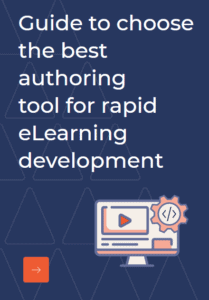Mobile learning was, is and will continue to be a hot topic as long as the mobiles and technology keep expanding. Today we discuss about how to create mobile eLearning using Authoring tools.
The process of creating a new mobile learning / mLearning course is quite similar to that of any custom eLearning project. Hence, the first and foremost step as usual is Need Analysis. To just give an overview it involves analyzing whether the organization requires mobile learning or not. If not, then your work ends there and if yes you move on to Content Gathering. This step can vary depending on whether it is a new course creation or conversion of existing eLearning to mobile learning. In the former case you have to give high importance to discussion with SMEs, collate all the information required. If it's the latter i.e. conversion of existing eLearning to mobile learning most of the information is already available and all you need to do now is convert it into mobile compatible format. The steps that essentially follow are these:
1. Identify the Technology
Depending on the requirement, in most cases mobile learning is created on HTML4 or 5 or a combination of both. It can be in form of a web-based app, a native app or a hybrid app. The key challenge in Mobile learning is multidevice compatibility and hence the technology supporting responsive design plays a crucial role.
2. Choosing the Right Authoring Tool
This step can be a bit tricky as the market is filled with authoring tools- Articulate, Captivate, Camtasia, gomo and Lectora to name a few. We have listed the top 10 picks for eLearning and compared three popular ones earlier. The selection truly depends on the type of output that you require- so say an authoring tool that can create HTML5 course and deliver multi device output.
3. Storyboarding
The process of storyboarding remains the same, but as it's a mobile first approach the design would focus on optimum view on a small screen. This also includes the types of images and videos, the way the text will be displayed, the instructions, mobile friendly controls etc. The process can be simplified depending on the type of authoring tool selected. For instance, Adobe Captivate Draft, an iOS-based app allows instructional designers to create storyboard directly in it including the content, question slides, branching logic etc. It can then be uploaded on cloud, reviewed and directly imported into Captivate 9 and be converted into a functional course.
4. Choosing the Templates
Most authoring tools come with a large template library that can be used to build the course. The in-built templates for mobile devices are available in several formats, and the color schemes can be easily modified to match your branding. Also, if required some of the templates can be customized as required.
5. Creating the Prototype
The biggest perk of an authoring tool for creating mobile learning is that using it doesn't need much expertise. So once, the assets have been imported, and interactions, themes, games, scenarios, people cutouts etc. that are required for the course are selected from the asset library of the authoring tool the next step is to create a prototype. You can also use the on-screen recording feature that some authoring tools offer to add short video snippets into your course. Prototyping helps in giving the clients a better idea about the final output. Reviews should be done for usability aspect too and client feedbacks listed to be incorporated in the final version (Beta version is it?). The final version should only be created once the prototype is approved.
6. Creating the Final Version
Prototyping also gives a hang of using the authoring tool and so by this time you know how to utilize the functionalities that the authoring tool provides. The final output is mostly in responsive format so as to cater to the multiplicity in devices-sizes & makes. Moreover, authoring tools also allow to publish in different languages in order to cater to a global audience if required.
7. Testing
Software testing as well as usability testing is equally important. Many authoring tools give an in-product LMS preview to see how your project will integrate with various SCORM-compliant LMSs. You can also use simulators, or actual devices for testing. Errors should be logged and corrections implemented. In most cases testing on actual devices can be of great help.
8. Deployment
With the help of Authoring tools the courses can be published/deployed directly to leading LMSs or as apps.
This in short is how mobile learning is created using an authoring tool. But, this is not a manual to be followed and so don't try creating one unless you know what you are doing. Mobile learning is still growing, and so are authoring tools. Few years down the lane authoring tools will have most of these steps simplified, but for now developers are better equipped when it comes to modifications or additional customizations to be done through authoring tools.
Does this cover the process well? Or have we missed out on any step? We would really like to hear from you, so do leave your comments below.



